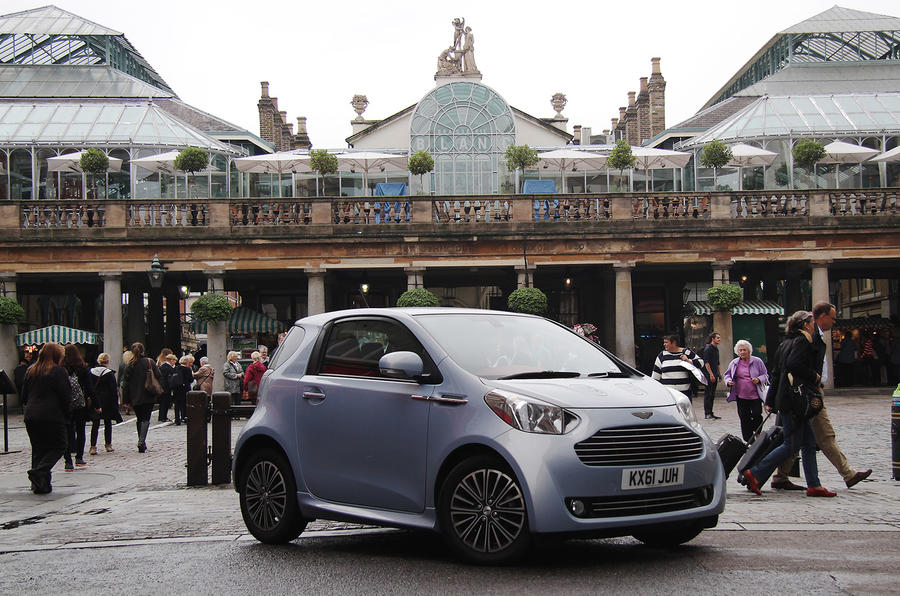It is entirely to his credit that despite the hand-bagging that he fully expects his car to receive, Duncan Johnson is still sufficiently game to lend me his Aston Martin Cygnet.
Unless you count things like the Tickford Metro, there has never been a car like the Cygnet and I suspect that it’ll be a while before there is again. Despite being, in real terms, the cheapest car ever to fly the Aston wings, it seems that to call sales glacial would be to insult slow-moving mountains of ice.
Although Aston goes all coy when you ask how many it has sold since the Cygnet went on sale in 2011, speculation suggests it was considerably less than 1000, and we do know that there are just 143 on UK roads, making it even less popular in its homeland than Aston’s biggest ever turkey, the late-1980s Virage.
Then again, Aston’s smallest ever turkey is not an Aston at all. Looking at it brought to mind those poor children in the US whose ghastly parents think that slathering them in make-up and entering them into beauty pageants is somehow consistent with them growing up into well-adjusted adults. Toyota provided the child in the form of an entirely blameless iQ. Aston Martin applied the slap.
I use the past tense because the Cygnet project is no more, and having never had the pleasure when it was new (inexplicably, no car was available), I still wanted to know what provoked Aston Martin to cosmetically reconstitute a 1.3-litre Toyota city car.
There was another reason, too: Duncan Johnson paid £15,000 for his perfect two-year-old Cygnet, which is very little more than you’d pay today for a new top-of-the-range iQ. At that level and given that, in the UK, Cygnets are outnumbered two to one by Mercedes-Benz SLSs, could it possibly even be a buy?
I was getting ahead of myself. At the time of the Cygnet’s creation, Aston boss Ulrich Bez provided us with three reasons for its existence, and it is fair to say that the first – Aston’s need for a sustainable product line-up – has not gone according to plan. No manufacturer launches a car intending it to spend fewer than three years in the marketplace.
The second was the desire to satisfy demand and, in this regard, the Cygnet has clearly succeeded insofar as anyone who wanted one could have one, at least once Aston abandoned its highly courageous original position of offering them to existing Aston customers only. Unfortunately, there just weren’t very many of them.
The third reason quoted was the need to reduce the average emissions of the Aston fleet ahead of ever more punitive environmental legislation being introduced around the world, which it undoubtedly would have done had it hung around long enough to finish the job. Now that the Cygnet has gone, I suspect more than ever that the recently announced ‘technical partnership’ with AMG is a mere harbinger of a much closer association with or even acquisition by Mercedes-Benz.































Join the debate
Add your comment
-
The mocking this car receives is purely down to badging. Had they called it a Toyota iQ 'by Aston Martin' - or something - I doubt it would have generated anything like as much negative press.
As others have pointed out, there are other high-spec, high-cost, hand-finished city cars out there over the years but none of them has swapped their original makers badge for something else. And none makes financial sense but that's not the point.
The rather pompous marketing spouted by Aston at the time, and backed up by certain factions of the motoring press, only added to the air of buffoonery.
I did see one
... in Reading a few weeks ago. I actually quite liked the look of it, and was glad it existed even thought I'd never consider buying one.
The Cygnet lacked credibility
I've seen two on the road, both in Central London. One was a promotional vehicle, and subjected to the most incompetent parallel parking manoeuvre I have ever seen, the second was occupied by a young Sloaney couple. Both attracted mocking comments from passers-by.
Give it a few years and they may well be received more warmly, but no one wants to be laughed at for the car they drive.
By the way, the VW XL1 is a totally different proposition, and a car that pushes the technological envelope. I can't believe people are equating it to this transparent branding exercise.
scrap wrote: By the way, the
So pray tell what envelope is it pressing, it brings no genuine technological advances whatsoever, its a a diesel hybrid in a plastic/carbon tub wrapped up in an aerodynamic impracticable body, with an interior made up from the VW parts bin, for £100k, its not exactly in the same league as an i8 which is the same price..